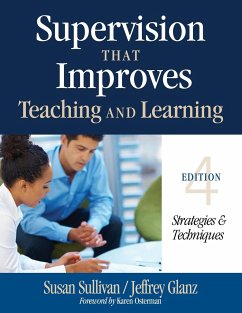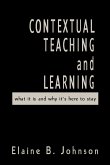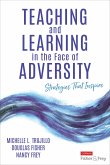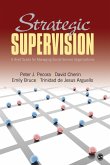Susan S. Sullivan, Jeffrey G. Glanz
Supervision That Improves Teaching and Learning
Strategies and Techniques
Susan S. Sullivan, Jeffrey G. Glanz
Supervision That Improves Teaching and Learning
Strategies and Techniques
- Broschiertes Buch
- Merkliste
- Auf die Merkliste
- Bewerten Bewerten
- Teilen
- Produkt teilen
- Produkterinnerung
- Produkterinnerung
Effective supervision is vital to instructional improvement, and this new edition of a bestseller pinpoints the techniques that matter most. Features 42 qualitative and quantitative observation tools.
Andere Kunden interessierten sich auch für
![Ben Franklin's Little-Known Scientific Formula Improves Selling Skills 52% Ben Franklin's Little-Known Scientific Formula Improves Selling Skills 52%]() Bob OrosBen Franklin's Little-Known Scientific Formula Improves Selling Skills 52%53,99 €
Bob OrosBen Franklin's Little-Known Scientific Formula Improves Selling Skills 52%53,99 €![Teaching Mathematics in the Visible Learning Classroom, Grades 6-8 Teaching Mathematics in the Visible Learning Classroom, Grades 6-8]() John T. AlmarodeTeaching Mathematics in the Visible Learning Classroom, Grades 6-843,99 €
John T. AlmarodeTeaching Mathematics in the Visible Learning Classroom, Grades 6-843,99 €![Contextual Teaching and Learning Contextual Teaching and Learning]() Elaine B. JohnsonContextual Teaching and Learning42,99 €
Elaine B. JohnsonContextual Teaching and Learning42,99 €![Supervision as Collaboration in the Human Services Supervision as Collaboration in the Human Services]() Michael J. AustinSupervision as Collaboration in the Human Services195,99 €
Michael J. AustinSupervision as Collaboration in the Human Services195,99 €![Teaching Mathematics in the Visible Learning Classroom, Grades 3-5 Teaching Mathematics in the Visible Learning Classroom, Grades 3-5]() John T. Almarode (USA James Madison University)Teaching Mathematics in the Visible Learning Classroom, Grades 3-543,99 €
John T. Almarode (USA James Madison University)Teaching Mathematics in the Visible Learning Classroom, Grades 3-543,99 €![Teaching and Learning in the Face of Adversity Teaching and Learning in the Face of Adversity]() Michelle L. TrujilloTeaching and Learning in the Face of Adversity21,99 €
Michelle L. TrujilloTeaching and Learning in the Face of Adversity21,99 €![Strategic Supervision Strategic Supervision]() Peter J. PecoraStrategic Supervision105,99 €
Peter J. PecoraStrategic Supervision105,99 €-
-
-
Effective supervision is vital to instructional improvement, and this new edition of a bestseller pinpoints the techniques that matter most. Features 42 qualitative and quantitative observation tools.
Hinweis: Dieser Artikel kann nur an eine deutsche Lieferadresse ausgeliefert werden.
Hinweis: Dieser Artikel kann nur an eine deutsche Lieferadresse ausgeliefert werden.
Produktdetails
- Produktdetails
- Verlag: SAGE Publications Inc
- 4 Revised edition
- Seitenzahl: 258
- Erscheinungstermin: 8. Februar 2013
- Englisch
- Abmessung: 280mm x 216mm x 14mm
- Gewicht: 666g
- ISBN-13: 9781452255460
- ISBN-10: 1452255466
- Artikelnr.: 35335600
- Herstellerkennzeichnung
- Libri GmbH
- Europaallee 1
- 36244 Bad Hersfeld
- gpsr@libri.de
- Verlag: SAGE Publications Inc
- 4 Revised edition
- Seitenzahl: 258
- Erscheinungstermin: 8. Februar 2013
- Englisch
- Abmessung: 280mm x 216mm x 14mm
- Gewicht: 666g
- ISBN-13: 9781452255460
- ISBN-10: 1452255466
- Artikelnr.: 35335600
- Herstellerkennzeichnung
- Libri GmbH
- Europaallee 1
- 36244 Bad Hersfeld
- gpsr@libri.de
Children's author Susan E. Sullivan worked in Nuclear Medicine before teaching high school biology and anatomy for ten years. Her dream of writing became a reality when her husband brought a cat home from a "garbaggy" place and he became part of their family. Bob, a tailless cat, had wanderlust and his true adventures became the source of great stories, ones that Susan crafted into a heartwarming picture book, Bob Tales: Land of the Woody Warbles.A rescue cat with a rough beginning, Bob loved his new family and any time they went away, the cat would set out on a journey to "find" them, sometimes for weeks, until he would finally be located and reunited with Susan and her husband. She would imagine what exploits would befall her sweet tailless cat on his travels and it inspired her to write about them.Susan believes a great book is one that evokes emotion and is full of adventure. She hopes her young readers come away from her story learning to always be kind, and to love all creatures, including humans, just the way they are, and that this stays with them long after the book is closed.When she isn't writing uplifting stories for kids, Susan enjoys being in nature and among animals, particularly when she is beekeeping. She also enjoys golf, paddle boarding, fishing and snow skiing. She lives with her husband in Beaufort, South Carolina with several rescue pets. Bob, who sadly passed away last year, continues to inspire Susan's writing, with a second picture book in the works following her debut, Bob Tales: Land of the Woody Warbles.
Foreword to the Fourth Edition by Karen Osterman
Preface to the Fourth Edition
Acknowledgments
About the Authors
A Brief Note to Instructors
1. The Changing Context of Supervision
What Is Supervision?
The Influence of History
Supervision in the Late 19th Century
Democratic Methods and Supervision
Standards-Based Supervision
Understanding the History of Supervision
Implications for the Practice of Supervision
Assessing Belief Systems
Conclusion
Notes
2.Three Interpersonal Approaches to Supervision
How We Learn
Listening, Reflecting, and Clarifying Techniques
Approaches to Providing Feedback
Guidelines for Reflective Practice
Summary
Notes
3. Observation Tools and Techniques
Supervision Scenario
Forty-Two Tools and Techniques for Observation
Quantitative Observation Tools
Qualitative Observation Tools
Summary
Conclusion
Notes
4. An Introduction to Reflective Clinical Supervision
A Definition of Clinical Supervision
The Reflective Clinical Supervision Cycle
Conclusion
5. Alternative Approaches: Case Studies and Implementation Guidelines
Instructional Rounds
Book Study Groups
Lesson Study Groups
Peer Coaching
A Journey: From Peer Coaching to Critical Friends
Portfolios for Differentiated Supervision
Action Research
Conclusion
Notes
6. Creating Transformational Change Through a Focus on Instructional
Supervision
Framework
The Case and Two Questions
Conclusion
7. Supervision to Improve Classroom Instruction: Next Steps
Next Steps
Guidelines for Creating a Supervisory Platform
"For Me, Personally": My Supervisory Platform
Conclusion - Or Just a Beginning?
Resource A. Microlab Guidelines
Resource B. Fishbowl Guidelines
Resource C. Technology in the Classroom: Tips That Span the Traditional to
the Virtual Classroom
Resource D. Observation Practice Sheets
References
Index
Preface to the Fourth Edition
Acknowledgments
About the Authors
A Brief Note to Instructors
1. The Changing Context of Supervision
What Is Supervision?
The Influence of History
Supervision in the Late 19th Century
Democratic Methods and Supervision
Standards-Based Supervision
Understanding the History of Supervision
Implications for the Practice of Supervision
Assessing Belief Systems
Conclusion
Notes
2.Three Interpersonal Approaches to Supervision
How We Learn
Listening, Reflecting, and Clarifying Techniques
Approaches to Providing Feedback
Guidelines for Reflective Practice
Summary
Notes
3. Observation Tools and Techniques
Supervision Scenario
Forty-Two Tools and Techniques for Observation
Quantitative Observation Tools
Qualitative Observation Tools
Summary
Conclusion
Notes
4. An Introduction to Reflective Clinical Supervision
A Definition of Clinical Supervision
The Reflective Clinical Supervision Cycle
Conclusion
5. Alternative Approaches: Case Studies and Implementation Guidelines
Instructional Rounds
Book Study Groups
Lesson Study Groups
Peer Coaching
A Journey: From Peer Coaching to Critical Friends
Portfolios for Differentiated Supervision
Action Research
Conclusion
Notes
6. Creating Transformational Change Through a Focus on Instructional
Supervision
Framework
The Case and Two Questions
Conclusion
7. Supervision to Improve Classroom Instruction: Next Steps
Next Steps
Guidelines for Creating a Supervisory Platform
"For Me, Personally": My Supervisory Platform
Conclusion - Or Just a Beginning?
Resource A. Microlab Guidelines
Resource B. Fishbowl Guidelines
Resource C. Technology in the Classroom: Tips That Span the Traditional to
the Virtual Classroom
Resource D. Observation Practice Sheets
References
Index
Foreword to the Fourth Edition by Karen Osterman
Preface to the Fourth Edition
Acknowledgments
About the Authors
A Brief Note to Instructors
1. The Changing Context of Supervision
What Is Supervision?
The Influence of History
Supervision in the Late 19th Century
Democratic Methods and Supervision
Standards-Based Supervision
Understanding the History of Supervision
Implications for the Practice of Supervision
Assessing Belief Systems
Conclusion
Notes
2.Three Interpersonal Approaches to Supervision
How We Learn
Listening, Reflecting, and Clarifying Techniques
Approaches to Providing Feedback
Guidelines for Reflective Practice
Summary
Notes
3. Observation Tools and Techniques
Supervision Scenario
Forty-Two Tools and Techniques for Observation
Quantitative Observation Tools
Qualitative Observation Tools
Summary
Conclusion
Notes
4. An Introduction to Reflective Clinical Supervision
A Definition of Clinical Supervision
The Reflective Clinical Supervision Cycle
Conclusion
5. Alternative Approaches: Case Studies and Implementation Guidelines
Instructional Rounds
Book Study Groups
Lesson Study Groups
Peer Coaching
A Journey: From Peer Coaching to Critical Friends
Portfolios for Differentiated Supervision
Action Research
Conclusion
Notes
6. Creating Transformational Change Through a Focus on Instructional
Supervision
Framework
The Case and Two Questions
Conclusion
7. Supervision to Improve Classroom Instruction: Next Steps
Next Steps
Guidelines for Creating a Supervisory Platform
"For Me, Personally": My Supervisory Platform
Conclusion - Or Just a Beginning?
Resource A. Microlab Guidelines
Resource B. Fishbowl Guidelines
Resource C. Technology in the Classroom: Tips That Span the Traditional to
the Virtual Classroom
Resource D. Observation Practice Sheets
References
Index
Preface to the Fourth Edition
Acknowledgments
About the Authors
A Brief Note to Instructors
1. The Changing Context of Supervision
What Is Supervision?
The Influence of History
Supervision in the Late 19th Century
Democratic Methods and Supervision
Standards-Based Supervision
Understanding the History of Supervision
Implications for the Practice of Supervision
Assessing Belief Systems
Conclusion
Notes
2.Three Interpersonal Approaches to Supervision
How We Learn
Listening, Reflecting, and Clarifying Techniques
Approaches to Providing Feedback
Guidelines for Reflective Practice
Summary
Notes
3. Observation Tools and Techniques
Supervision Scenario
Forty-Two Tools and Techniques for Observation
Quantitative Observation Tools
Qualitative Observation Tools
Summary
Conclusion
Notes
4. An Introduction to Reflective Clinical Supervision
A Definition of Clinical Supervision
The Reflective Clinical Supervision Cycle
Conclusion
5. Alternative Approaches: Case Studies and Implementation Guidelines
Instructional Rounds
Book Study Groups
Lesson Study Groups
Peer Coaching
A Journey: From Peer Coaching to Critical Friends
Portfolios for Differentiated Supervision
Action Research
Conclusion
Notes
6. Creating Transformational Change Through a Focus on Instructional
Supervision
Framework
The Case and Two Questions
Conclusion
7. Supervision to Improve Classroom Instruction: Next Steps
Next Steps
Guidelines for Creating a Supervisory Platform
"For Me, Personally": My Supervisory Platform
Conclusion - Or Just a Beginning?
Resource A. Microlab Guidelines
Resource B. Fishbowl Guidelines
Resource C. Technology in the Classroom: Tips That Span the Traditional to
the Virtual Classroom
Resource D. Observation Practice Sheets
References
Index








